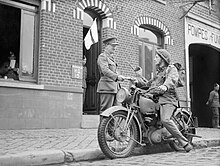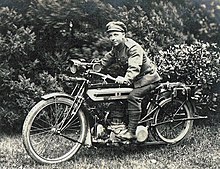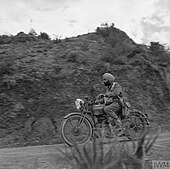Despatch rider

Adespatch rider(or dispatch) is a military messenger, mounted on horse or motorcycle (and occasionally in Egypt during World War I, on camels).[1]
In the UK 'despatch rider' is also a term used for amotorcycle courier.
Despatch riders were used by armed forces to deliver urgent orders and messages between headquarters and military units. They had a vital role at a time whentelecommunicationswere limited and insecure. They were also used to delivercarrier pigeons.
World War I
[edit]
United Kingdom
[edit]
In theBritish Army,motorcycle despatch riders were first used in World War I by theRoyal Engineers Signal Service.When the War Department called for motorcyclists to volunteer with their machines for despatch work at the start of August 1914, the response was huge.[2]The London office had 2000 more applicants than places, and a similar response was reported in regional centres around the country. If a rider and machine were approved then £10 was paid immediately, £5 to be paid on discharge (unless due to misconduct), and pay was 35s per week. The motor cycle would be taken over at valuation price, or would be replaced with a new one at the close of operations. Enlistment was for one year or as long as the war might last. The preference was for 500cc single cylinder machines and the horizontally-opposed twin cylinder. All machines had to have a "change speed gear". The following list of spares was also required to be carried:
- One valve complete with spring, washer and cotter
- One sparking plug
- One piston ring
- A tyre repair outfit including spares for valve
- A spare tube
- A spare belt and fastener (if belt driven)
- Spare link and a spare chain (if chain-driven)
- Complete set of spares for the magneto
- Selection of nuts and washers
- Two valve cap washers (if used on machine)
- Complete set of tools
- Two gaiters for tyre repairs
- A spare 'cover' to be carried by signal units for each machine (a tyre)
Recruitment was not just for the army; theAdmiraltyin Chatham bought 50Triumphsin 1914 for despatch rider duties, and many unsuccessful applicants were accepted byScotland Yardon different terms to patrol country districts and distribute royal proclamations. These bikes carried a plate on the front with the lettering "O.H.M.S.".
As the war progressed the wide variety of volunteered machinery presented maintenance and spares problems, and so were progressively replaced by a limited range of military models, and in specific regions of the world or parts of the service only one of these models might be found, for example the RAF (formerly the RFC) exclusively usedP&Mmotorcycles by the later stages of the war (they also included female riders).[3]
Other Nations
[edit]In August 1914 it was reported that the despatch riders for the Belgian and Russian armies were equipped exclusively withF.N. motor cycles.[4]However, one month later the Belgian government ordered 50 3 hpEnfieldmotorcycles for despatch riders. At this time the French Army were still mobilising, but it was reported they had a squad of Triumphs as well as a variety of French makes.[2]Douglassupplied 100 machines to the Italian Government for despatch purposes in 1916, and by this time the French despatch riders were also usingBSAsand Triumphs.[5]
The US Army entered the war in 1917, and their messengers were equipped principally withIndianandHarley-Davidsonmotorcycles.
A September 1914 account states that French despatch riders, like the British, are equipped with revolvers, whereas their German counterparts are equipped withMausers.[6]

World War II
[edit]During World War II despatch riders were often referred to as Don Rs (fromphonetic spellingfor D in "DR" ) in Commonwealth forces.[7]In World War II,Royal Corps of Signalssoldiers carried out the role and theRoyal Signals Motorcycle Display Teamwas formed from their number. They were also used by theRoyal Air Forceand theRoyal Navy,where they maintained contact with land bases and some of the riders were members of theWomen's Royal Naval Service.In the UK,Bletchley Parkinitially received transmissions from thelistening stations(Y-stations) by despatch rider, but this was later switched to teleprinter transmission.
The British military often usedTriumph,Norton,BSA,MatchlessandArielfor despatch riders, and although radio communications were much more advanced during WW II than WW I - huge numbers were produced (e.g. over 75,000Norton 16Hmodels).
Contemporary
[edit]
The German army reintroduced despatch riders in 2019, equipped with theBMW F850GS,in order to be capable of communicating under heavy electronic warfare conditions.[8]
Notable riders
[edit]- Charles Kingsford Smith- Aviator
- Charles Symonds- Neurologist
- Bessie Stringfield- Motorcyclist
- Jehan Alain- Composer and Despatch Rider (French 8th Division)
References
[edit]- ^"Despatch Riders on Camels", The Motor Cycle, 12 October 1916, p320
- ^ab"Military Motor Cycle Notes", The Motor Cycle, 13 August 1914
- ^"A Visit to an RAF Reception Depot", The Motor Cycle, 18 July 1918, p50
- ^"The Home of the F.N.", The Motor Cycle, 13 August 1914, p225
- ^The Motor Cycle, 7 December 1916, p498
- ^"With our fighting forces", The Motor Cycle, 10 September 1914, p334
- ^"WW2 People's War: The Story of a Don R."BBC. 15 October 2014.Retrieved19 May2018.
- ^"Der Melder kommt zurück - Kradmelder bei der Bundeswehr".13 May 2019.
Memoirs of riders
[edit]- W. H. L. Watson.Adventures of a Motorcycle Despatch Rider During the First World War:ISBN978-1-84685-046-2
- Raymond MitchellCommando Despatch Rider:ISBN0-85052-797-X
- Albert Simpkin - edited by David Venner. "Despatch Rider on the Western Front 1915–1918: The Diary of Sergeant Albert Simpkin MM"ISBN978-1473827400
Further reading
[edit]- Carragher, Michael (2013).San Fairy Ann? Motorcycles and British Victory 1914–1918.Brighton: FireStep Press.ISBN978-1-908487-38-4.
